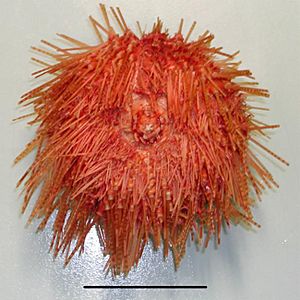Diadema palmeri facts for kids
Quick facts for kids Diadema palmeri |
|
|---|---|
 |
|
| Diadema palmeri specimen collected in New Zealand | |
| Scientific classification | |
| Genus: |
Diadema (sea urchin)
|
| Species: |
palmeri
|
The Diadema palmeri is a fascinating red sea urchin that lives deep in the ocean. It belongs to a group of sea urchins called the Diadematidae family. These creatures are known for their long, sharp spines.
This special sea urchin was first found by a person named William (Bill) Palmer. He discovered it about 40 meters (130 feet) deep in the water. This was near the Poor Knights Islands, a small group of islands off the coast of New Zealand.
Contents
Where Does the Palmer's Sea Urchin Live?
The Diadema palmeri is not just found near New Zealand. It also lives in other warm, subtropical parts of the South Pacific. Scientists have found it in deeper waters around:
- New Zealand's Kermadec Islands
- Australia's lower east coast, from Danger Point to Montague Island in New South Wales (sometimes as deep as 200 meters!)
- Lord Howe Island
- The Norfolk Island Ridge
How Deep Do They Live?
These sea urchins prefer to live in deeper parts of the ocean. They are often found at depths of 40 meters (130 feet) or more. Some have even been spotted as deep as 200 meters (about 650 feet)! This means they live in areas where sunlight doesn't reach very well.
What Makes the Palmer's Sea Urchin Special?
The Diadema palmeri is known for its striking red color. Like other sea urchins, it has a round body covered in spines. These spines help protect it from predators. They also help it move around on the seafloor.
What Do Sea Urchins Eat?
Most sea urchins are herbivores, meaning they eat plants. They often graze on algae that grows on rocks. They use special mouthparts to scrape their food.
How Do Scientists Study Them?
Scientists like Alan N. Baker, who officially described this species in 1967, study sea urchins to learn more about ocean life. They use special equipment to explore deep-sea environments. This helps them understand where these creatures live and how they fit into the ocean's ecosystem.

